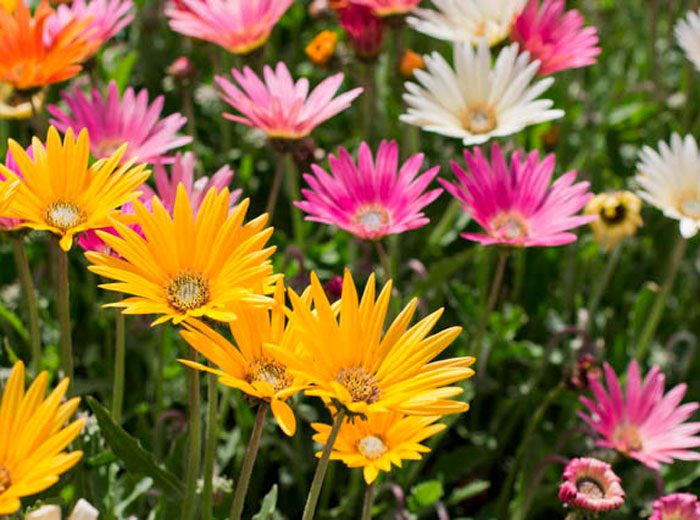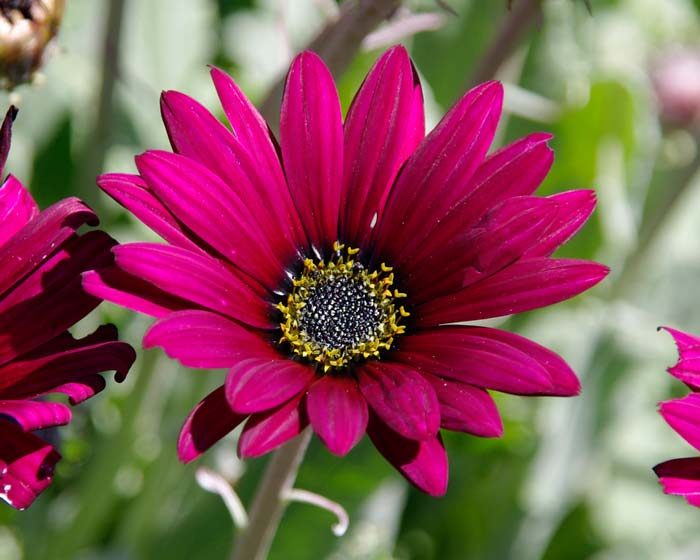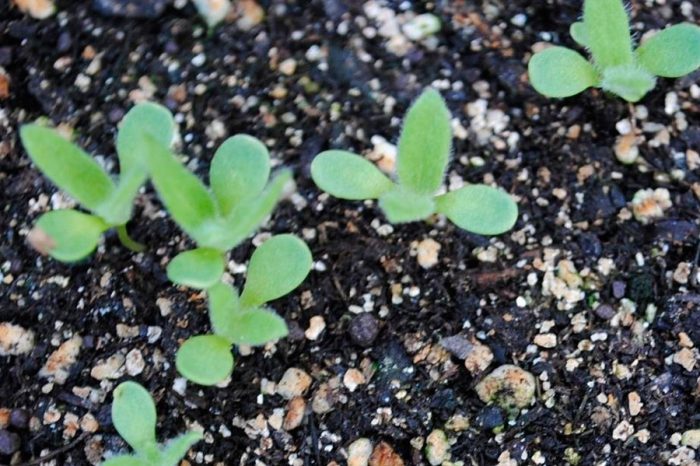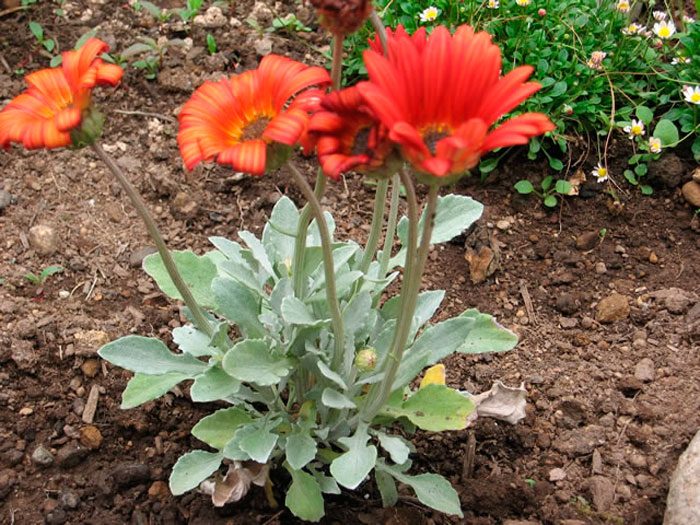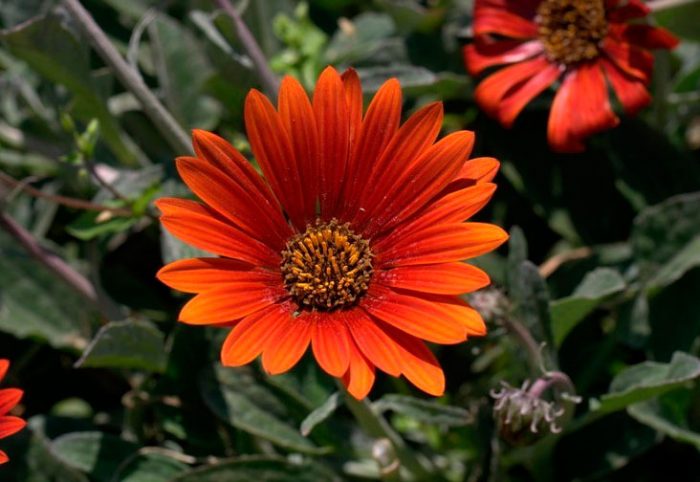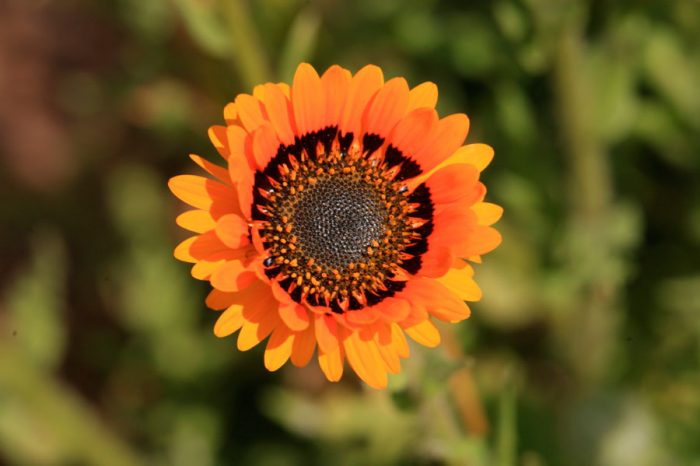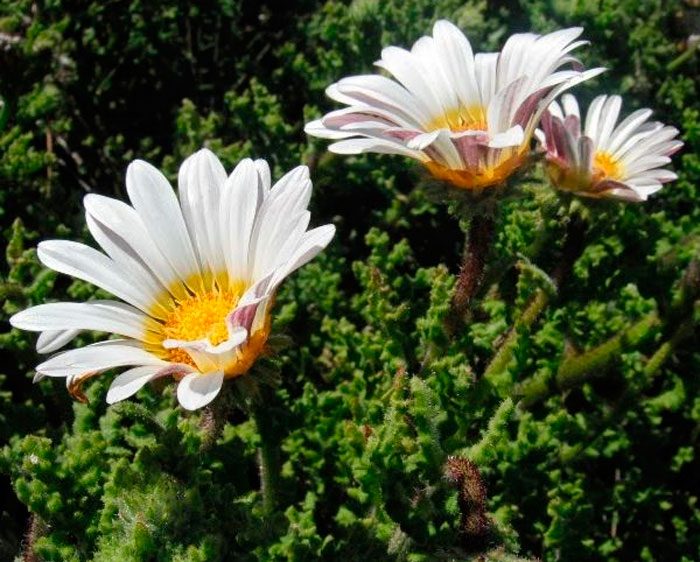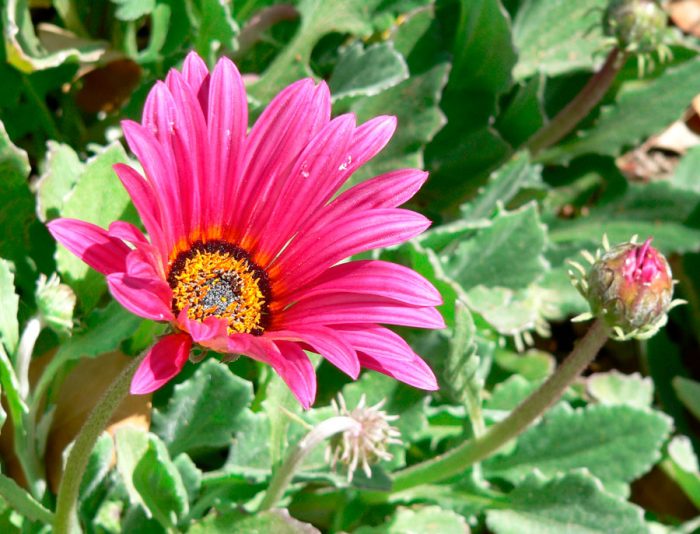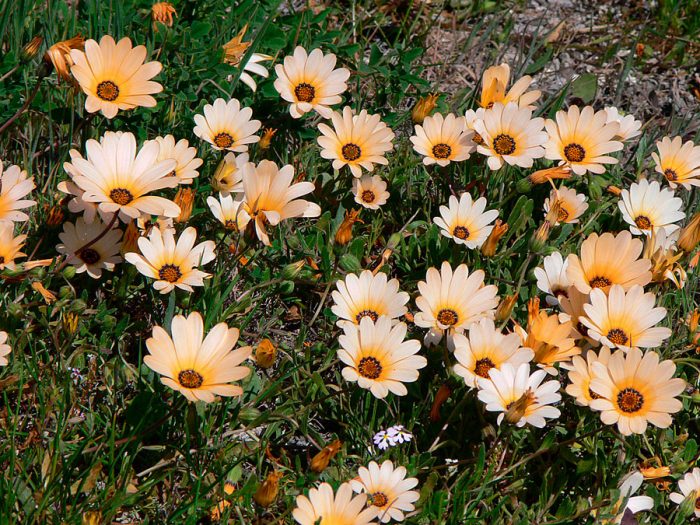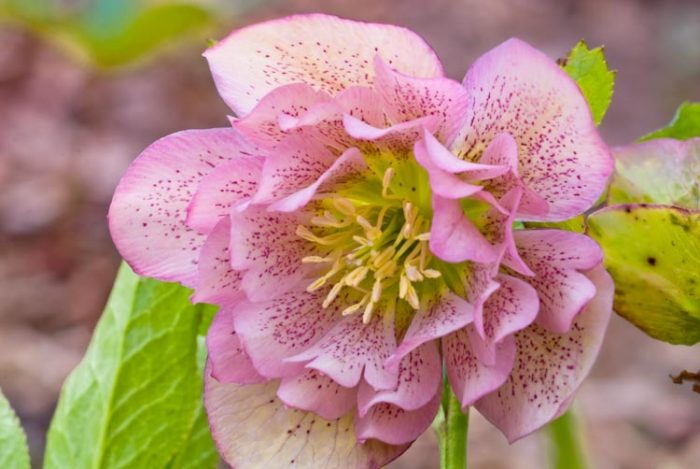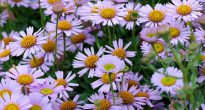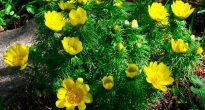The flowering plant Arctotis is a member of the Astro family. This genus unites about 70 species. Some of these species are considered endemic to the Cape region, about 30 are found in Africa south of Angola and Zimbabwe, and another part grows in South America. The name of this plant is translated from Greek as "bear's ear", this is due to the fact that the bush has a very dense pubescence. Arctotis has been cultivated for over a century.
Content
Features of arctotis
In nature, arctotis is represented by shrubs and herbaceous plants. On the surface of the foliage and shoots there is a dense pubescence of white or silver color. Alternately or oppositely located leaf plates have a wavy or notched-toothed shape. Saucer-shaped inflorescences-baskets in diameter reach 50-80 mm, outwardly they are very similar to chamomile or gerbera. Single flowers are located on long peduncles, they include marginal ligulate flowers of purple, yellow, white or pink color, as well as tubular median flowers, painted in purple, purple or brown. The composition of the multi-row inflorescence wrapper includes many scales. The fruit is a brownish-gray seed with a tuft. The seeds remain viable for 2 years.
Arctotis is a perennial, annual and biennial. Perennial species in regions with a relatively cool climate are grown as an annual.
Planting arctotis in open ground
Growing arctotis from seeds
Arctotis can be grown from seed and is best done through seedlings. It is quite simple to grow seedlings of such a beautiful flower. It is recommended to sow seeds in mid-March, for this they are laid out in peat pots of 3-5 pieces. Take a pallet and place all the pots there, which then need to be covered with glass or film on top. The first seedlings will appear after about 7 days. It is not recommended to grow seedlings of this culture in a common container, since it tolerates picking extremely poorly.But if, nevertheless, for sowing, for example, a box was used, then the seedlings during the formation of 2 true leaf plates will need to be cut into pots, with 3 plants planted in each. After the height of the seedlings reaches 10-12 centimeters, they should be pinched to make the bushes more lush.
Seedlings are planted in open soil only when the threat of return spring frosts is left behind, as a rule, this time falls on the second half of May or the first days of June. Before starting planting, the plants must be hardened so that they can get used to the new conditions. To do this, the seedlings should be transferred to the street every day, while the increase in the duration of this procedure should be gradual. It should be noted that after 15 days of hardening procedures, the seedlings should be able to stay outside around the clock.
Planting holes must be made keeping a distance of 0.25–0.4 m between them. In them, you need to carefully cross the plant, while trying not to destroy the clod of earth. In the event that the seedlings were grown in peat pots, then they should be planted together with these containers. The holes should be covered with soil, the surface of which should be slightly compacted. The planted plants need abundant watering.
How to plant arctotis in the garden
In regions where spring comes relatively early, and it is quite warm, it is quite possible to sow arctotis seeds in open soil in the first days of May. This culture is distinguished by its photophilousness, in this regard, the site should be open and sunny. Suitable soil must be well-drained, and lime must be present in its composition. This plant is not recommended for growing on clay and damp soil. During sowing, 4 or 5 seeds should be placed in each well. The distance between the planting holes is strongly influenced by the species and variety of arctotis grown. So, between tall plants, a distance of at least 0.4 m should be observed, and between undersized plants - about 0.25 m. After the seeds are sealed, the surface of the site needs to be tamped a little, then it is watered well. The first seedlings can be seen after about 10 days, and after only 10-12 days they are thinned out. If the plant is properly cared for, it can begin to bloom after 8 weeks.
Arctotis garden care
It is quite simple to care for arctotis grown in the garden, you just need to water it in a timely manner, weed, feed it, loosen the soil surface, pinch it, and also treat it from pests and diseases, if the need arises.
This crop is highly resistant to drought, the root system of the bushes is able to extract moisture from the deep layers of the soil. In this regard, arctotis does not need frequent watering. However, during a prolonged drought, it is still necessary to water it from time to time, especially when you consider that it is much easier to loosen and weed the moist soil surface.
Mandatory feeding for this plant is not needed. However, during the formation of buds and flowering, the bushes are still recommended to be fed with complex mineral fertilizer. Organics are not used for feeding this culture.
Do not forget, in a timely manner, remove the baskets that have begun to fade, which affects the more active formation of new buds. Often tall bushes need a garter to support.
Diseases and pests
This crop is highly resistant to diseases and pests. However, meadow bugs and aphids can still settle on the bushes. If arctotis is planted on wet soil, as well as during prolonged rains, there is a high probability of developing gray rot.
To eliminate meadow bugs, the bushes must be treated with a solution of mustard (for 1 bucket of water 100 grams of dry powder) or onion infusion. If necessary, treatment can be done with an insecticidal preparation. Aphids are a sucking insect that feeds on plant sap, and it is also one of the main carriers of viral diseases that are considered incurable. To get rid of it, you should use insecticides, for example: Aktellik, Fitoverm, Aktara, etc.
If a bush is damaged by gray rot, it must be removed from the soil and destroyed, since such a disease cannot be cured. The remaining bushes must be sprayed with a fungicide solution, for example, Fundazol.
After flowering
Plants grown as annuals, after they lose their showiness, are dug up and burned. And with the onset of autumn, you need to remove plant residues from the site, and then dig it up. In regions with a cool climate, all arctotis species are cultivated as annuals. In the southern regions of Russia and Ukraine, it is quite possible to grow perennial species of this plant, but only for the winter they need to be very well covered. In late autumn, you should cut off the part of the bush that is located above the ground. Then the surface of the site must be mulched with a thick layer of bark, straw or sawdust, the flower garden is covered with a nonwoven material or spruce branches on top.
Types and varieties of arktotis with photos and names
In the middle latitudes, not many species of arctotis are cultivated.
Arctotis short-stemmed (Arctotis breviscapa)
This perennial plant is a compact bush, the height of which does not exceed 15 centimeters. The homeland of this species is South Africa. On the surface of the shoots and leaf plates, there is a white tomentose pubescence. The marginal ligulate flowers are colored deep orange. Cultivated since 1812
Arctotis rough (Arctotis aspera)
The homeland of this species is also South Africa. The height of the bush varies from 0.4 to 0.5 m. In middle latitudes, this species is cultivated as an annual. The diameter of the inflorescences-baskets is about 50 mm, they include tubular yellow flowers and yellow ligulate flowers with brown streaks.
Arctotis stemless (Arctotis acaulis = Arctotis scapigera)
This species is a perennial and has a strong taproot. The length of the pinnately dissected leaf plates is about 20 centimeters, their front surface is green, and the back is whitish, because there is pubescence on it. Baskets reach about 50 mm in diameter, they include reed flowers of yellow color with a purple lining, as well as tubular flowers of red-black color.
Arctotis stoechadifolia (Arctotis stoechadifolia)
This species is also from South Africa. This perennial plant is cultivated in mid-latitudes as an annual. Strongly branched greenish erect shoots are about 100 cm high, and their surface is covered with pubescence, consisting of a soft pile of white-silver color. Asymmetrical dense sheet plates have a lanceolate-oval shape, their edge is serrated-wavy. They are opposite, and on their surface there is a tomentose pubescence. The lower leaf plates are petiolate, and the upper ones are sessile. On long peduncles there are single graceful inflorescences, their smell is rather weak, but very pleasant. They include marginal flowers of a snow-white color, and their bases are yellow-golden, while their lower surface is light purple. They also consist of small tubular flowers of violet-gray color, in the middle of the basket they form a bluish-steel disc. On a cloudy day, the inflorescences close. It has been cultivated since 1900. There is a variety of grandis: in contrast to the main species, its leaf plates are longer, the baskets are also larger.
Arctotis hybrid (Arctotis x hybridus)
This species combines complex hybrids that are popular with gardeners. They are obtained by crossing different species of arctotis. these hybrids can be grown both as annuals and as perennials, it all depends on what the climate is in your area. Not very often gardeners cultivate such species as: auricular arctotis - the color of the reed flowers is rich yellow; beautiful - the edge flowers are blue; lush or magnificent - with large orange marginal flowers. The most popular varieties are:
- Pink Suga... The marginal flowers are orange-yellow from the middle to the base, and lilac-pink from the ends to the middle.
- Mahogeni... The tubular flowers are green, and the marginal ones are orange-terracotta.
- Hailey... The color of the reed flowers is bright yellow, and the middle includes black and dark yellow cylindrical circles.
- Brick Red... The color of the reed flowers is red, and the middle is dark brown-yellow.
Also in the culture, the Harlequin variety mixture is quite popular, which includes varieties of various colors.
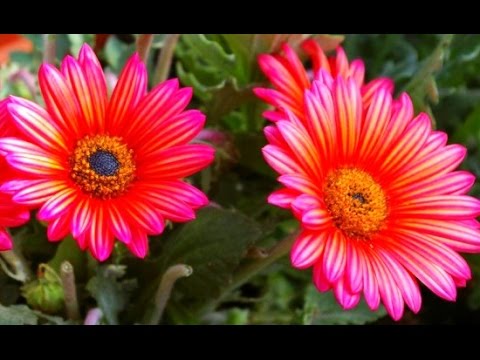

Watch this video on YouTube

